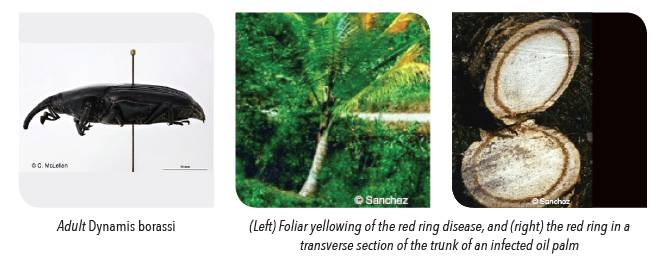General Information

Dynamis borassi is a major pest of coconut palms, Cocos nucifera, in Ecuador, Colombia and Brazil. The adult weevil attacks and destroys unopened inflorescences and terminal tissues. It has also been reported to attack and develop in the inflorescences of Astrocaryum carnosum and Astrocaryum chonta and is attracted to the maturing fruit of Astrocaryum standleyanum in Colombia. Infestations on the Arikury palm, Syagrus schizophylla and S. vagans are fatal. D. borassi have been recovered from oil palm plantations in Colombia but no damage has been recorded on oil palm (Elaeis guineensis). Other hosts for D. borassi include Borassus spp.
The weevil is a vector for the red-ring disease nematode, Rhadinaphelenchus cocophilus. Young coconut palms (as young as 1.5 years) are especially susceptible to the red-ring disease. Palms infected with the red-ring nematodes usually die within 2 to 4 months. The disease occurs more commonly in trees of 2.5 to 10 years old, with greatest incidence in those of 4 to 7 years old.
Dynamis borassi can harbour as many as 10 000 juvenile nematodes. Only a few nematodes are needed in wounds/ oviposition sites for infection. Adult female weevils deposit the nematodes during oviposition, usually at the apical regions (e.g. palm crowns). Nematodes can also be carried on the bodies of the weevils and enter hosts through wounds. Once inside, the nematodes colonize the stems of palm trees, leaf petioles and occasionally in the roots, start feeding and reproducing in palm tissue. The diseased palm starts wilting and eventually dies. The cycle repeats as the weevil larva and pupa co-exist with the nematodes in the host, and spread once the adult weevil tunnel out of the dying host and disperse to healthy palms. The weevils are attracted to moisture in the South American palm weevil Dynamis borassi frond bases and/or semiochemicals, produced by wounds on healthy palms and by stressed palms, and/or male- produced aggregation pheromones, which recruit both sexes of weevils to the host for mating and oviposition.
Distribution
Widespread in Central and South America.
Detection and Inspection
Dynamis borassi primarily attacks and destroys unopened inflorescent and apical region of palm crowns. The larvae remain inside the galleries they build in the trunk. Therefore, the pest can only be detected when damaged plants start to die, or by using pheromone-baited traps.
ADULT
Adults are deep-black in colour with a oblong-oval body. The males are 46 to 50 mm long and are 18 to 20 mm wide. The females are smaller – 43 to 45 mm long and are 16 to 18 mm wide. The body is flat dorsally and convex ventrally. Rostrum is glabrous.
PUPAE
Yellowish-brown, elongate-oval, widest at third abdominal tergite, gradually tapering anteriorly and posteriorly. Body is 44 mm long and 20 mm wide.
LARVAE
Brownish-yellow, large, with several small sclerotised setacarrying regions. Head capsule is dark brown and tapers posteriorly with curved sides, with two longitudinal subparallel, dorsal depressions at the centre of frons between frontal setae pairs 1 and 2. Ocellus absent. Antenna placed at anterior end of frontal suture. Young instar is 22 to 32 mm long and 8 to 11 mm wide with a head length of 5.5 to 10 mm and width of 4.5 to 8.5 mm. Mature larva is 44 mm long and 14 mm wide, with a head length 10.5 mm, width 9.5 mm.
EGGS
Eggs are 1.1 by 3.7 mm in size, yellowish-brown, smooth, slightly shining, slender, cylindrical with broadly rounded ends, slightly broader at the anterior end. The chorion and vitelline membrane are sometimes distinct. Adults prefer to oviposit eggs in living terminal tissues.
Prevention and Control
PHYTOSANITARY
The import of germplasm material (seeds, pollen, tissue culture) must be accompanied by an import permit issued by or on behalf of the Director-General Department of Agriculture for Peninsular Malaysia (including Labuan), or the Director Department of Agriculture for Sabah, and a phytosanitary certificate issued by an authorised official from the country of export. The import conditions are available upon request from the Plant Biosecurity Division Malaysia. All consignments are subjected to inspection by the Department of Agriculture prior to clearance by Customs. Germplasm material imported from high risk areas should be sent for third country quarantine before arrival onto Malaysian shores.
CULTURAL CONTROL AND SANITARY METHODS
The most widely used control method is the capture of adults with traps. Baits using a combination i) rotting plant materials, such as palm or sugar cane and ii) pheromones (e.g. 4-methyl-5-nonanol or synthetic racemic pheromone) can be used.
Further reading
- Bronson, C H (2010). Pest Alert: The Red Ring Nematode, Bursaphelenchus cocophilus. DACS-P-01748.
- CABI, C P C (2017). Rhadinaphelenchus cocophilus (red ring nematode). URL: http://www.cabi.org/cpc/ datasheet/47035
- Couturier, G; O’brien, C W and Kahn, F (1998). Astrocaryum carnosum and A.chonta (Palmae), New Host for the Weevil Dynamis borassi (Curculionidae: Rhynchophorinae). Principes, 42(4): 227-228.
- Giblin-Davis, R M; Gries, R; Gries, G; Pena-Rojas, E; Pinzon, I; Perez, A L; Pierce, H D Jr and Oehlschlager, A C (1997). Aggregation pheromone of palm weevil. Dynamis borassi. J. Chem. Ecol. 23(10): 2287- 2297.
- Giblin-Davis, R M; Oehlschlager, A C; Perez, A; Gries, G; Gries, R; Weissling, T J; Chinchilla, C M; Peña, J E; Hallett, R H; Pierce, H D Jr and Gonzalez, L M (1996). Chemical and Behavioural Ecology of Palm Weevils (Curculionidae: Rhynchophorinae). The Florida Entomologist, 79(2): 153-167.
- Howard, F W; Moore, D; Giblin-Davis, R V M and Abad, R G (2001). Borers of Palms. In Insect on Palms. CABI International: UK. p. 270-279.
- Malo, E A (2009). Tropical Insect Chemical Ecology. In Tropical Biology and Conservation Management Vol. VII. EOLSS Publishers/UNESCO: Oxford, UK. 98 pp.
- Mariau, D (transl. by Biggins, P.) (2001). The Fauna of Oil Palm and Coconut: Insect and Mites Pests and their Natural Enemies. CIRAD: Montpellier. 152 pp.
- Walker, K (2007). South American palm weevil (Dynamis borassi). In PaDIL. URL:http://www.padil.gov.au
- Wattanapongsiri, A (1966). A revision of the genera Rhynchophorus and Dynamis (Coleoptera: Curculionidae). Department of Agriculture Science Bulletin, Vol. 1. Bangkok (TH).

